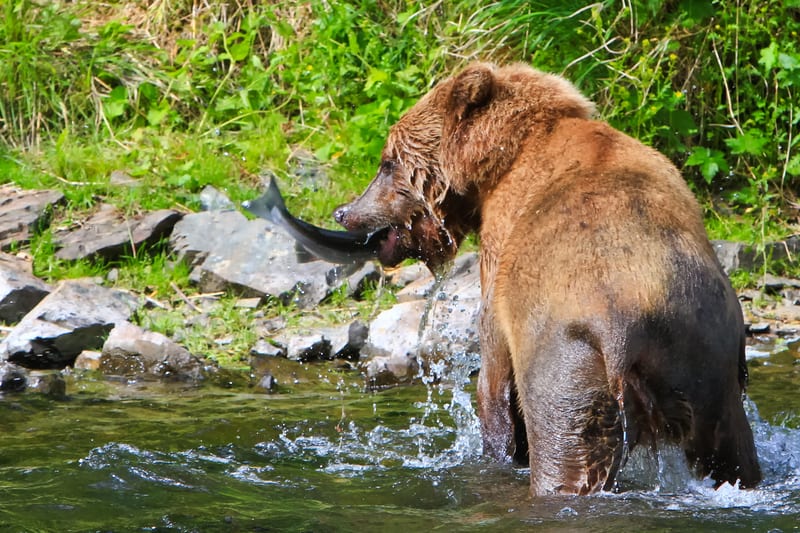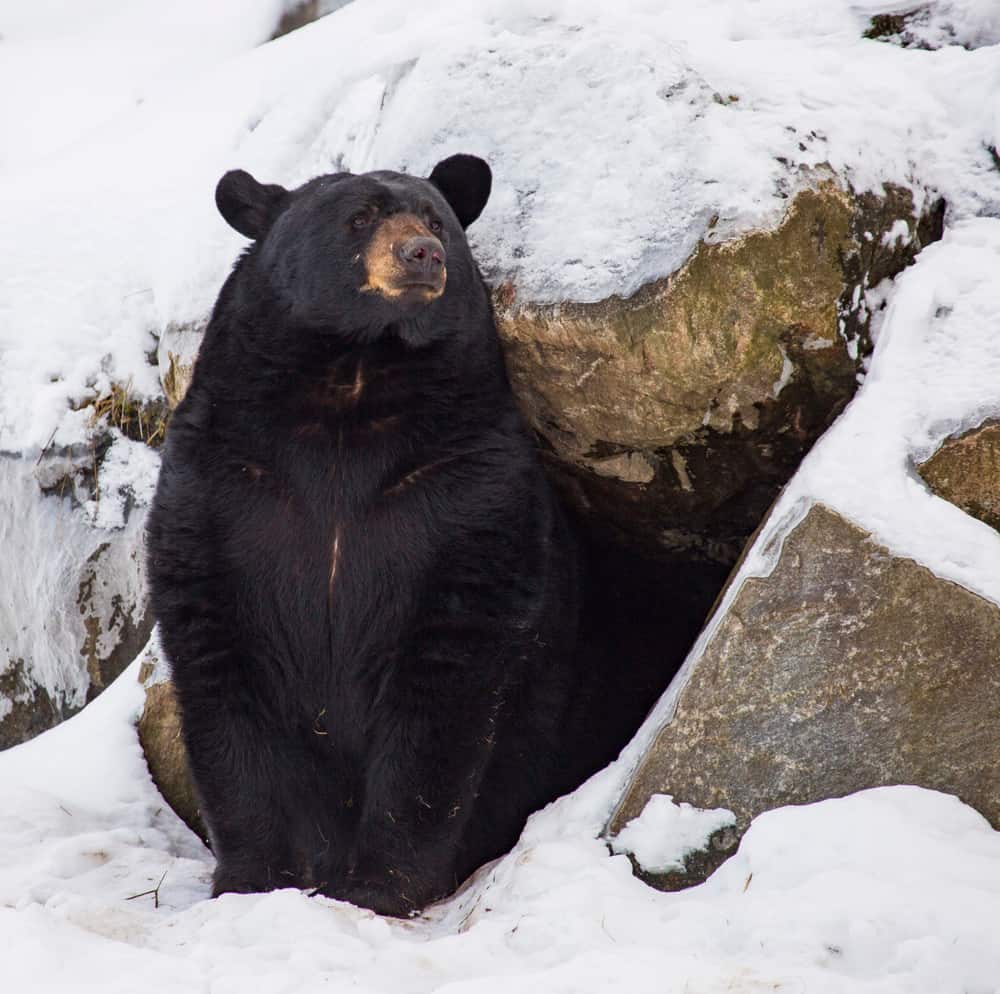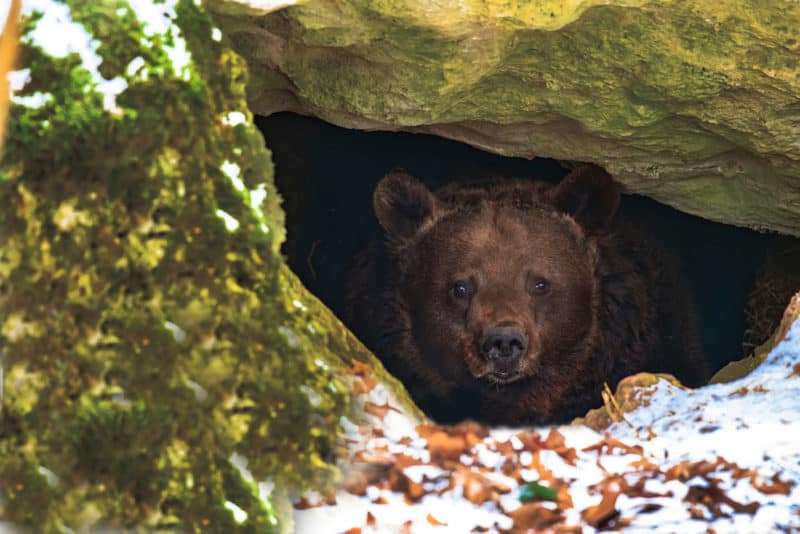Do Bears Hibernate?
Yes, most bears do hibernate. A large percentage of bear habitat in North America, Europe, and Asia goes through extremely cold conditions in the winter. During this time, not only is it cold, but their food supply becomes very limited. To complicate things more, if the snow piles too deeply, even mobility becomes difficult.
Over eons of time, most bears have developed physiological adaptations that enable them to live with these conditions. Essentially, they stock up on extra calories when food is plentiful and then go into a den and sleep for a majority of the winter. While they’re sleeping, their bodies break down their own body fat to use as energy and keep them alive.
Most bears do hibernate in the winter. However, the process that they go through is slightly different than that of the animals that science classifies as deep hibernators. Bears are light sleep hibernators, along with opossums, raccoons and skunks. Their metabolism slows way down along with their pulse and respiratory rates, but their body temperature stays relatively warm, and they don’t sink into as deep a state of sleep as that of a “deep hibernator.”
I’ve heard it said that what bears enter into in the winter is not hibernation but merely a form of torpor. The first half of this statement is incorrect, while the second half is correct. We’ll explain why below.

Hibernation vs Torpor
Torpor
Torpor is a state of being where an animal’s metabolism slows way down. In medical terms, it’s a hypometabolic state. Animals go into torpor to reduce the number of calories they need to take in to survive during times of adverse conditions. Thermoregulation, or the act of body temperature regulation, uses 40 to 60% of the energy that an animal takes in. Source To cut down on energy costs when it’s cold, or times of food scarcity, some animals go into torpor.
Some animals, such as marsupials, go through daily torpor. Daily torpor lasts for less than 24 hours and is then followed by continued foraging.
Hibernation
Other animals go through long-term torpor. This long-term torpor can last for months when animals sleep and go without eating or drinking. This long-term torpor is otherwise known as Hibernation. Source
Bear Hibernation
According to the manuscript titled, “BEHAVIOR, BIOCHEMISTRY, AND HIBERNATION IN BLACK, GRIZZLY, AND POLAR BEARS” by Ralph A. Nelson, Edgar Folk, Egbert W. Pfeiffer, John J. Craighead, Charles J. Jonke, and Dianne L. Steiger; Black and Grizzly bears pass through 4 physiological stages in a year.
Stage 1 – Hibernation. Studies by Edgar Folk, conclude that American black bears and grizzly bears are true hibernators. They go through physiological modifications similar to those in deep hibernators. They have decreases in heart rate, metabolic rate, and body temperature. However, their hibernation differs from that of deep hibernators in that bears hibernate at near-normal body temperature and continuously sleep. On the other hand, deep hibernators such as bats and rodents hibernate at near ambient temperatures and wake up from time to time to eat, drink, urinate, and defecate.
Stage 2- Walking Hibernation. After bears emerge from their winter dens, they go through a period of adjustment called walking hibernation. From 10-14 days, they take in very little food or water. Analysis of their urine and blood shows that even though they are awake physiologically, they are still in hibernation mode. Walking hibernation lasts for 2-3 weeks. Bears then begin to eat and drink normally and return to normal activity.
Stage 3- Normal Activity. From late spring to early fall, bears are in stage 3. At this time, they can consume 5,000 to 8,000 calories per day.
Stage 4- Hyperphagia. This is where they are packing on enough body fat to last through winter hibernation. Their daily food intake increases dramatically. Grizzly bears in hyperphagia observed in the wild feed up to 20 hours a day in the late fall to prepare for hibernation. During this time, bears transition from consuming around 8000 calories to packing on 15 to 20 thousand calories each day, along with copious amounts of water to help them process what adds up to a lot of food.

Around the middle of October, the bear’s body goes through hormonal changes. They cease to be interested in gorging on food, and their appetite diminishes considerably. At this point, their body transitions into torpor mode.
They will soon enter their winter den and begin hibernating. Tangles of tree roots, crevices in rocks, hollow trees, and sometimes even vacant buildings get utilized as bear dens. The hibernation time for bears varies with the environment. In places with harsh winters, like northern Canada and Alaska, bears hibernate up to six months out of the year. A hibernating bear’s heart rate drops to 8-10 beats per minute. Additionally, they only average 1 breath per minute Bears’ body temperatures do not plummet like their pulse and breathing rates do. A bear in hibernation still has a body temperature of 88° F (31°C). This is only 12° F lower than their normal temperature.
Even though they are asleep, hibernating bears still burn a lot of calories. By the time they wake up in the spring, they will have lost up to 33% of the weight they had before hibernation began. Source

Bear Hibernation, in Contrast to the Hibernation of Deep Hibernators
The bodies of ‘deep’ hibernators shut down almost entirely during the winter. Their temperatures plummet to near-ambient numbers, as do their metabolic rates. Some of these species, like the chipmunk, periodically wake up for brief periods to move around, eat, drink, or pass waste, while others, such as the bat, go the entire winter without food or water.
This is not the case when it comes to bears. They do not enter such an intensely deep sleep. While their metabolism slows down considerably, their body temperature drops only slightly compared to that of a deep hibernator. Their sleep is light enough that changes in the temperature of their surroundings, or any disturbance, will arouse them.
The Physiological Changes That Take Place During Hibernation.
The state of hibernation makes sure that the animal can survive harsh climatic conditions by causing physiological changes. So, with bears, what are these psychological changes?
When a bear is in hibernation mode, its body goes into a state of metabolic suppression. The bear’s heart rate and breathing rate both drop markedly. During the entire period of hibernation, the bear neither urinates nor defecates. As a result, the level of nitrogen in the blood increases significantly. If this happened in a human body, the damage to the organ tissues of the liver and kidneys would be detrimental, maybe even fatal. However, the case is different with bears because nothing of the sort is observed.
Additionally, the bear’s body becomes resistant to insulin. Normally, insulin is essential in making sure that blood sugar levels remain at an optimal range. However, with an animal that has fasted for several months, insulin in the blood keeps glucose from being available to the brain. Source
Six months of continuous sleep for other animals would result in the muscles entering a state of atrophy. Additionally, the animal’s bones would become brittle and porous, a condition; known as osteoporosis. However, bears come through hibernation with no bone loss. They retain their muscle and bone mass in hibernation. They actually end up with more muscle mass, even though their body weight decreases by up to 33%.
The nitrogen in the bear’s body, a byproduct of fat metabolism, is synthesized to produce proteins, which are then used to maintain their organ and muscle mass. Moreover, the bear’s body can recycle its water, ergo avoiding dehydration and conditions like kidney failure.
Black bears, brown bears, and grizzly bears generally do not eat, drink, urinate or defecate during hibernation. They normally survive on a fat layer built up during the fall and summer months. Note that their bodies produce waste, but they recycle it instead of disposing of it.
Bear Reproduction
It’s during the hibernation period that female bears give birth. Though bears have a summer mating season, they have delayed implantation. In other words, the fertilized egg doesn’t implant in the female’s uterine wall until the winter starts. Pregnant females give birth approximately 2 months later, in late January or early February. The newborn cubs do not hibernate. They’re born hairless and blind but not completely helpless. They find their mother’s nipples and nurse to stay alive. They obtain all the nutrients they need through their mother’s milk. On the other hand, mother bears stay in a state of on-and-off hibernation until they emerge from their dens in the spring.
Do Black Bears in Florida Hibernate?
Florida’s bears do not hibernate, but they do enter a light state of torpor. Bears time their hibernation cycles to correspond with times of scarcity and times of plenty. In more northerly latitudes, bears hibernate to escape the harsh climatic conditions that come with the winter and conserve energy since food sources become rare or completely unavailable.
Bears in southern states do not have to hibernate to escape cold temperatures because it’s relatively warm all year round. January is the coldest month in Florida, for example, and the average temperature for the state is still 58.1°.
The American Black bears in Florida enter a state of lethargy because even though conditions aren’t as severe as they are in northern latitudes, there’s still less food availability there than there is during the summer months. They don’t hibernate, though.
When Do Black Bears Come Out of Hibernation?
Bears hibernate at different times, depending on their sex. For adult males, the state of hibernation starts around early December and ends in the middle of March. Adult female bears, because they give birth during winter, normally take longer to come out of hibernation. Theirs starts in late November and ends in early April when they emerge from their dens with their cubs.
How Long Do Bears Hibernate in Alaska?
The bears in the northern regions of Alaska hibernate for about six months. They hibernate for longer periods because the winter in northern Alaska is longer. Longer winters necessitate longer hibernation periods. In the warmer southern, regions of Alaska, the bears hibernate for 2 to 5 months. During this winter dormancy, bears are in dens that they’ve dug out beneath boulders or downed trees or some other sheltering object. They also use tree cavities or natural caves as winter denning sites.
Do Polar Bears Hibernate?
Polar bears go through the same physiological changes that black bears and grizzly bears do, but there is no set pattern as to when it will take place. In general, they will go into a kind of walking hibernation in the summer months, where they need and consume very little food. Blood tests done on some of these bears indicate that physiologically they are in a similar state to stage 2 for a Black or Grizzly bear. Sometimes they will even den in the summer but not always.
They spend the winter months hunting seals on the pack ice. This is the time that generally they’re laying on fat against the time when food is harder to find
Polar bears may temporarily den in the winter when the weather is especially severe. At this time, they’re not in a state of hibernation.
Pregnant female polar bears do build and go into dens, where they give birth and raise their cubs until they’re three months old. During this time, the female bear doesn’t eat or drink. Instead, she depends on her fat reserves to sustain herself and her cubs. Again, she is in a state of torpor at this time but not in a state of complete winter sleep.
Recent Posts
The only venomous snakes in Washington State are Northern Pacific Rattlesnakes. The Northern Pacific Rattlesnake (Crotalus oreganus oreganus) is a sub-species of the Western Rattlesnake. Anyone...
Skunks are not classified as true hibernators. But they go into a state of torpor when the weather gets cold. Skunks are light sleep hibernators, along with opossums, bears, and raccoons. ...

